
MAY CONTAIN NUTS

Search Shorpy
SHORPY ART

Framed or unframed, desk size to sofa size, printed by us in Arizona and Alabama since 2007. Explore now.
Join and Share
Ad-Free Shorpy
Shorpy is funded by you. Patreon contributors get an ad-free experience.
Learn more.

Recent comments
- Tough Guys
- Lost in Toyland
- And without gloves
- If I were a blindfolded time traveler
- Smoke Consumer Also Cooks
- Oh that stove!
- Possibly still there?
- What?!?
- $100 Reward
- Freeze Frame
- Texas Flyer wanted
- Just a Year Too Soon
- WWII -- Replacing men with women at the railroad crossing.
- Yes, Icing
- You kids drive me nuts!
- NOT An Easy Job
- I wonder
- Just add window boxes
- Icing Platform?
- Indiana Harbor Belt abides
- Freezing haze
- Corrections (for those who care)
- C&NW at Nelson
- Fallen Flags
- A dangerous job made worse
- Water Stop
- Passenger trains have right of way over freights?
- Coal
- Never ceases to amaze me.
- Still chuggin' (in model form)
Member Photos
The Shorpy
Print Emporium
Print Emporium
Search Shorpy
Search results -- 30 results per page
- Over the River: 1902
- ... account of Kate on the net as well.
Boone-area railroads Boone and Scenic Valley (with their Chinese-built steam loco) ... a stereoview of this somewhere...
(The Gallery, DPC, Railroads, W.H. Jackson) ... Posted by Dave - 08/03/2012 - 3:04pm -
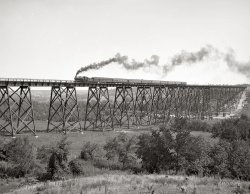
- Feeding Station: 1942
- ... train should look.
(The Gallery, Chicago, Jack Delano, Railroads) ... Posted by Dave - 03/11/2024 - 11:06am -
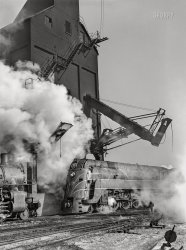
- Checkin Tender: 1942
- ... View full size.
(The Gallery, Chicago, Jack Delano, Railroads) ... Posted by Dave - 03/18/2024 - 10:36am -
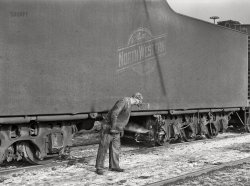
- Frosty Freight: 1942
- ... View full size.
(The Gallery, Chicago, Jack Delano, Railroads) ... Posted by Dave - 03/16/2024 - 8:56pm -
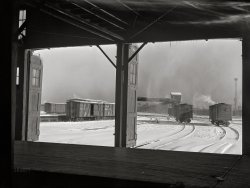
- Lonesome Highway: 1942
- ... in the U.S.
(The Gallery, John Vachon, Landscapes, Railroads, Rural America) ... Posted by Dave - 03/02/2024 - 11:53am -
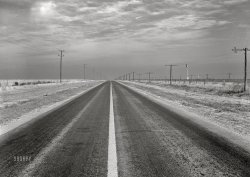
- Animal Trap Company: 1942
- ...
(The Gallery, Factories, Marjory Collins, Railroads, WW2) ... Posted by Dave - 02/28/2024 - 7:59pm -
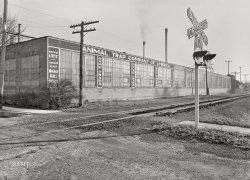
- The Hotel Essex: 1906
- ... to me.
(The Gallery, Boston, DPC, Railroads) ... Posted by Dave - 02/09/2024 - 4:53pm -
![The Hotel Essex: 1906 Boston circa 1906. "Atlantic Avenue elevated at Hotel Essex (Terminal Hotel)." Completed in 1900, now the Plymouth Rock Building. 8x10 glass negative, Detroit Publishing. View full size.
How could they resist?I can attest that certain letters -- always the same letters -- were often out in the neon sign on the roof, resulting in HOT SEX. Clearly, this was not due to chance, but creative vandalism.
Gone? Then what is this?https://maps.app.goo.gl/HeJRkk4dkxWC9dP79
Really echoes the architecture of the Hotel Essex. Is this just a similar building in a close location (next to South Station. I guess if it was industrial, then look alike buildings could be all over I guess?)
[Oh right. Not gone! - Dave]
Despite certain neon letters not working properly... this is the cleanest 1906 photograph I've ever seen.
Fireproof, as featured inFireproof Magazine, July 1906. No interior photographs or floorplans, but the architect is identified, Arthur Hunnewell Bowditch. His Wikipedia page doesn't include the Hotel Essex among his notable projects. But, in 1931/32 he designed the Art Deco Paramount Theater, the last of the great movie palaces built in downtown Boston.
Looking at the two 1906 photographs and Street View, I'm certain there was a second-floor entrance to the Hotel Essex, directly from the elevated train platform. A nice perk for guests.
If only --So 120 years ago, I could walk to my local train station and arrive at South Station, walk out and up the stairs to wait for the next elevated train to my office at North Station. But today, I have to go below ground and take two overcrowded subway rides to get to the same location. MBTA, please bring back the Atlantic Avenue line!
Platform AdsOne of the advertisements I can see on the platform is for Mennen's Toilet Powder. The rest are inscrutable to me.
(The Gallery, Boston, DPC, Railroads)](https://www.shorpy.com/files/images/SHORPY-4a13543a.thumbnail.jpg)
- Lil Shuckers: 1906
- ... slice of the Gulf Coast will disappear too.
Oyster Railroads
North & South, Vol. 3, 1904.
Oysters and ... the ships come in and pull up alongside the little "oyster railroads" with their miniature trains of cars standing easy to receive them. ... Posted by Dave - 08/15/2012 - 3:53pm -
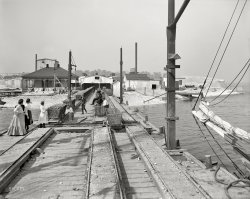
- Chenoa Depot: 1905
- ... -- things are getting busy in Chenoa! So here are the two railroads mentioned earlier, resulting in the station being called a union ... a distant signal for the interlocking limits ahead. Two railroads went through town, the Chicago and Alton (C&A), and the Toledo ... Posted by Dave - 08/21/2012 - 12:39pm -
![Chenoa Depot: 1905 Circa 1905. "Station & buildings at Chenoa, Illinois." Plus: circus posters! 8x10 inch dry plate glass negative, Detroit Publishing Company. View full size.
Changes in a few yearsHere's a post card found online, dated c. 1911, that shows the station from another side. It looks to be the wrong size at first glance, but refer back to the Shorpy photo and note how oversize the doors and windows are compared to the man checking out the postings by the door.
A row of trees have been planted. The express company building appears to be moved or removed by about 1911.
Diamonds/crossings and new track are in place right by the station -- things are getting busy in Chenoa! So here are the two railroads mentioned earlier, resulting in the station being called a union depot in the post card inscription.
In the 1911 picture, I wonder how long that (electric?) line lasted hanging over the tracks? It had to have been blasted by stack exhaust from engines that passed under it.
Circus stars leave townI see the trunk escape artists are waiting on the platform.
WaitingFor the 5:25 from Joliet.
OS ChenoaTo bad Bobby Troup didn’t roll Chenoa into his famous tune, “Route 66.“ Looks like a train departing after dropping off freight for the United States Express Company to handle. Train order board is at stop, most likely for the occupied block the departing train is in. My guess is that the smaller semaphore is a distant signal for the interlocking limits ahead. Two railroads went through town, the Chicago and Alton (C&A), and the Toledo Peoria and Western (TP&W). The TPW is still at it, owned by Rail America. I get a glimpse of their trains in Kentland, Indiana now and again while rambling on highway 41. The old C&A is now part of the Union Pacific. Can only wonder which main is pictured.
Graffiti or signage?Look to the right at that smaller structure. I think I see a prancing horse painted on a panel.
[That's a seal on one of the circus posters mentioned in the caption. - Dave]
When railroads interesctYou end up with beautiful little Midwest towns like this. Even today it's hard to find towns this small except in the middle of nowhere whose form and function derived from being on a rail line. It's still a small beautiful town.
Passing ByThis past March, my wife and I drove past Chenoa on I-55. We were returning to the Bull City from a Shorpy-inspired visit to Dwight. I guess next time we'll stop in Chenoa.
(The Gallery, DPC, Railroads)](https://www.shorpy.com/files/images/4a20205a.thumbnail.jpg)
- Illinois Central: 1942
- ...
(The Gallery, Chicago, Jack Delano, Railroads) ... Posted by Dave - 01/31/2024 - 4:09pm -
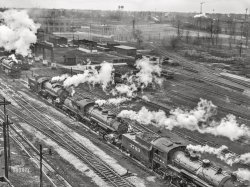
- See You in Iowa: 1943
- ... the entire trip!
(The Gallery, Chicago, Jack Delano, Railroads) ... Posted by Dave - 01/26/2024 - 8:39pm -
![See You in Iowa: 1943 January 1943. "Conductor handling engineer copy of train orders before a Chicago and North Western freight pulls out of Chicago for Clinton, Iowa. Since the track between those points is under automatic train control, the engineer hands the conductor the key to the automatic train control lock of the engine. The conductor will keep the key in the caboose until the train arrives at its destination." Acetate negative by Jack Delano, Office of War Information. View full size.
What a beastJack Delano sure knew how to capture the essence of steam engines. That locomotive positively looms behind the two humans. It is a thing of power and beauty.
C&NW Class H-1 LocomotiveAttached is a photo of 3014 charging across farmland taken at about the same time as this. The H-1 was a 4-8-4 "Northern" type loco -- one of the final modern steam engines used by the North Western before dieselization. Interestingly, Mr. Delano has set a telephoto equipped camera upon the air pump seen above the heads of the crew.
[LOL! - Dave]
Here Casey!Smoke one of mine. It'll keep ya warm for the entire trip!
(The Gallery, Chicago, Jack Delano, Railroads)](https://www.shorpy.com/files/images/SHORPY-8d11758a.thumbnail.jpg)
- Carrier Mills: 1939
- ... taken in June, 1938.
(The Gallery, Arthur Rothstein, Railroads, Small Towns, Stores & Markets) ... Posted by Dave - 02/04/2024 - 8:43pm -
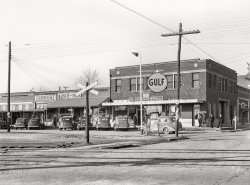
- Trackwork: 1942
- ... and nine shovels.
(The Gallery, Chicago, Jack Delano, Railroads) ... Posted by Dave - 01/17/2024 - 2:55pm -
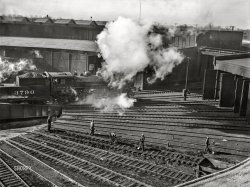
- Henrietta: 1943
- ... Depot today View Larger Map
Naming Railroads Atchison, Topeka (and the) Santa Fe sounds great. It's also the ... have the same ring to it.
(The Gallery, Jack Delano, Railroads) ... Posted by Dave - 06/04/2009 - 11:10am -
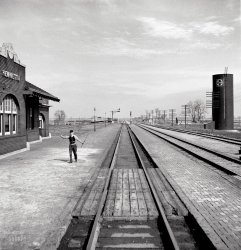
- I.C.R.R.: 1942
- ... with this shot.
(The Gallery, Chicago, Jack Delano, Railroads) ... Posted by Dave - 01/16/2024 - 4:47pm -
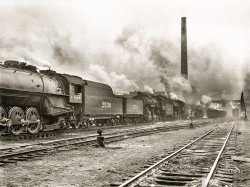
- Engine of Change: 1942
- ... past and present.
(The Gallery, Chicago, Jack Delano, Railroads) ... Posted by Dave - 01/08/2024 - 7:29pm -
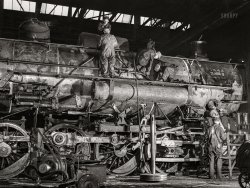
- The North Yard: 1942
- ... no.
(The Gallery, Chicago, Jack Delano, Landscapes, Railroads) ... Posted by Dave - 01/11/2024 - 1:36pm -
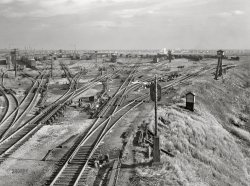
- Yardwork: 1942
- ... camera. - Dave]
(The Gallery, Chicago, Jack Delano, Railroads) ... Posted by Dave - 01/09/2024 - 3:11pm -
![Yardwork: 1942 November 1942. "Chicago, Illinois. Tender and switch engine at an Illinois Central railyard." Acetate negative by Jack Delano for the Office of War Information. View full size.
FuzzyAt first I couldn't figure out if it was my glasses needed changing or a part of the photo was out of focus. Come to the conclusion probably both!
[It's in focus -- twice. Maybe something bumped the camera. - Dave]
(The Gallery, Chicago, Jack Delano, Railroads)](https://www.shorpy.com/files/images/SHORPY-8d09741u.thumbnail.jpg)
- Oil Train: 1942
- ... oil supplies.
(The Gallery, Chicago, Jack Delano, Railroads) ... Posted by Dave - 01/09/2024 - 3:05pm -
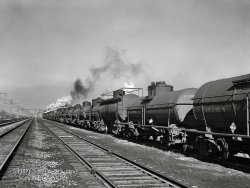
- PneuTube: 1942
- ... tie.
(Technology, The Gallery, Chicago, Jack Delano, Railroads, The Office) ... Posted by Dave - 01/05/2024 - 3:13pm -
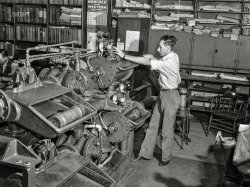
- Copper Hopper: 1942
- ... going on.
Third - Still scary.
(The Gallery, Mining, Railroads, Russell Lee) ... Posted by Dave - 11/30/2023 - 2:29pm -
![Copper Hopper: 1942 September 1942. Deer Lodge County, Montana. "Anaconda smelter, Anaconda Copper Mining Company. Cars containing 50 tons of copper ore are dumped by an unloading mechanism into a 200-ton hopper." Acetate negative by Russell Lee, Office of War Information. View full size.
Waste notI've never seen such sight. What happened to the cart that rolled into that chamber on those tracks? Did it just roll off the tracks down into oblivion along with its load of copper? And look at the flimsy housing they built around such a powerful impressive machine. Strange.
[That "cart" is a fifty-ton railcar. It goes back on the train tracks after being emptied. - Dave]
NOW I see the railcar still in there. I didn't realize I was looking at the back of the railcar. I thought it was just the back of the chamber. ¯\_(ツ)_/¯
STAND BACK!That is one nasty pinch-point.
The car on the tracksis actually still on the rails. The mechanism which rolls the car over clamps the car and the tracks together, and as soon as the car is empty, it rolls on over so that the car can be rolled out of that area. This is same way that coal cars are emptied at electric power plants. In most cases the cars have couplers which can swivel so that a car still in a train can also be emptied, one car at a time.
Impressions ProgressFirst - What are we looking at?
Second - Ok, now we get what's going on.
Third - Still scary.
(The Gallery, Mining, Railroads, Russell Lee)](https://www.shorpy.com/files/images/SHORPY-8d08614u.thumbnail.jpg)
- Yard Cop: 1942
- ... for Mr. Vachon's camera.
(The Gallery, John Vachon, Railroads) ... Posted by Dave - 12/04/2023 - 11:27am -
![Yard Cop: 1942 October 1942. "Tulsa, Oklahoma. Mid-Continent Petroleum Corp. refinery, Tulsa station of the Great Lakes pipeline. Armed railroad guard inspecting an oil tank car in the yards." Medium format acetate negative by John Vachon for the Office of War Information. View full size.
The trusty WinchesterI've seen pictures of the yard cop with a night stick. Winchester is the baseball bat. I guess for the war effort and saboteurs?
Changing job focusA few years earlier the railroad yard cop would have been after hobos; movies of the 1930s have many such scenes. By 1942, war and economic activity had largely solved the hobo 'problem'. Now the concerns were sabotage, theft of raw materials, and security in general.
The Case of the Missing Journal LidSomeone obviously pilfered it! The oil-filled journal box should have a snug-fitting cover, as seen on the one at far left, to keep rain water and road dust out of the bearing area. The journal box closest to the gun-toting lawman seems to have taken its leave?
Black and White HeatA rifle ... next to an oil tank(er)??? Guess he didn't see the movie (But he had a good excuse: it wouldn't be released until seven years later)
Vintage graffiti?I hadn't thought about graffiti in 1942. But then why not. Much less ugly than spray paint!
[Those are yard-crew markings. - Dave]
How StylishIn a three-piece suit & tie complete with handkerchief, this fellow seems quite overdressed. Railyards (especially in the days of steam locomotives) were very dirty places. Bib overalls would have been more appropriate. Maybe he spends time in an office or just wanted to look good for Mr. Vachon's camera.
(The Gallery, John Vachon, Railroads)](https://www.shorpy.com/files/images/SHORPY-8d44981a.thumbnail.jpg)
- Copper Country: 1942
- ... (The Gallery, Factories, Industry & Public Works, Mining, Railroads, Russell Lee) ... Posted by Dave - 11/29/2023 - 3:08pm -
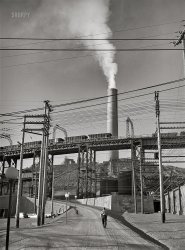
- Big Mack: 1942
- ... Cars, Trucks, Buses, Industry & Public Works, John Vachon, Railroads) ... Posted by Dave - 12/05/2023 - 12:31pm -
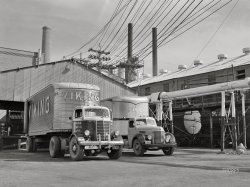
- NA-TI-ON-AL LIFE: 1905
- ... BUT Implosion!!! they gather in the hundreds.
Railroads, coal and money Wonder about the dominant businesses of the day? ... Posted by Dave - 07/18/2013 - 4:21pm -
![NA-TI-ON-AL LIFE: 1905 Circa 1905. "Williamson Building, Cleveland." Bonus points to the first person to transcribe all those windows. 8x10 inch glass negative. View full size.
I'm impressed by how clear these old photos are.Can anyone tell me the type of camera that would have taken this photo? The edge to edge clarity is pretty remarkable for something 100+ years ago.
[This photo was taken with a view camera on a photographic glass plate that measured 8 x 10 inches. -tterrace]
Boom!Imploded in 1982 to make way for the Sohio (later BP) skyscraper. It served as the headquarters for the Federal Reserve Bank of Cleveland from 1914 to 1923.
Final MinuteMy son and I watched and photographed the final moments of the Williamson Building but, as the huge dust cloud rolled across Public Square we, and hundreds of others, became quite alarmed. There was a telephone booth nearby so we ducked into it and continued to shoot photos of the bewildered spectators. Scan of prints from 35 mm color negs.
ImagineSignage such as this on a 'modern' skyscraper. I can just imagine the dentist's office on the 25th floor with a nice, hand painted tooth in his window, touting his painless services.
Euclid AvenueThis photo overlaps this recent one.
Euclid Avenue exits to the right in the current photo. The big arch on the Williamson Building is at the extreme left edge of the previous photo. The "Otis" building was home to the Painless Dentist and Weiss Credit, as can be seen by matching up the upper Moorish windows. The streetcar switch on the upper (westbound) track at the far right of this photo would be the one controlled by the trolley wire contactor in the previous photo.
Come & Go awayFew people gather to admire the beauty in the construction of old buildings. BUT Implosion!!! they gather in the hundreds.
Railroads, coal and moneyWonder about the dominant businesses of the day? More railroad offices than I've ever seen in one place; bankers, brokers,insurance; and so much coal. (And some ice.) This was clearly commerce central.
Rail officesThe cluster of rail offices are offline freight agents. I have no idea what they actually did or how one went about determining how to route freight shipments but almost all cities had dozens of freight agents representing various lines. Baltimore & Ohio apparently has the largest offices and they served Cleveland through a branch line but had multiple routes through Ohio and neighboring states.
Great photo!
Because I have no lifeI transcribed all the windows in the Corner Building -- as much as was readable. The pdf is here.
(The Gallery, Cleveland, DPC, Streetcars)](https://www.shorpy.com/files/images/SHORPY_4a12710a.thumbnail.jpg)
- Mineral Electric: 1942
- ... Information. View full size.
(The Gallery, Mining, Railroads, Russell Lee) ... Posted by Dave - 11/30/2023 - 2:18pm -
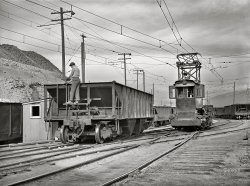
- Office Cubicle: 1911
- ...
(The Gallery, Cars, Trucks, Buses, Cleveland, DPC, Railroads, Streetcars) ... Posted by Dave - 11/13/2023 - 2:36pm -
![Office Cubicle: 1911 Cleveland, Ohio, circa 1911. "Brotherhood of Locomotive Engineers Bldg., St. Clair Avenue and Ontario Street." 8x10 inch dry plate glass negative, Detroit Publishing Company. View full size.
The whole building?B of LE Building ... does that mean the brotherhood used the whole building?
[They owned the whole building. - Dave]
Full frontalSo we get the glamour shot of what we only had a tantalizing glimpse of a half-year ago. Still around, and still durned impressive ... or incredibly monotonous, depending on your preferences.
[Er, no. That "tantalizing glimpse" was of a different building. - Dave]
We can take comfort in being wrong together: you're pointing to the building across the street - which wasn't built until a decade after this picture, and I was mistaken that this is extant ... sadly
StaredownIs that a Studebaker electric facing off with that horse?
No Safety BarriersThe unfinished streetcar tracks catch my eye and how it is not surrounded by any sort of safety barriers - another reminder of how it was a different time back then. Also, wonder what the BoLE Auditorium looked like. Probably not as ornate as what would be created in another 10-15 years.
Safety lastA torn up street and no barricades or traffic cones. Must have been before personal injury lawsuits were invented.
At home in ChicagoThis style is from the Chicago School of architecture, which emphasizes the building's structural grid, uses relatively little ornamentation, and has large plate-glass window areas. I think it's a good look, especially considering that buildings would eventually be clad in only glass curtain walls.
(The Gallery, Cars, Trucks, Buses, Cleveland, DPC, Railroads, Streetcars)](https://www.shorpy.com/files/images/SHORPY-4a24063a.thumbnail.jpg)
- The Vanderbilt: 1907
- ... tracks. Syracuse was notorious for its street level railroads with supposedly up to 100 trains a day traveling down the middle of ... Washington Street tracks.
And more about the early railroads of Syracuse .
Trolley guards The tracks coming in from ... Posted by Dave - 08/18/2015 - 7:59pm -
![The Vanderbilt: 1907 Syracuse, New York, 1907. "Vanderbilt House." With "Credit Parlors," billiards, a bowling alley and Trunks just around the corner. 8x10 inch dry plate glass negative, Detroit Publishing Company. View full size.
Jamestown Exposition "Held in Norfolk, Virginia, from April 26 to November 30, 1907"
Perhaps that narrows the date down a little closer, or maybe they were selling tickets in advance, for $15.45?
[Oh! Good eye. - Dave]
The reason there are no streetcarson those tracks is because they are not streetcar tracks. Syracuse was notorious for its street level railroads with supposedly up to 100 trains a day traveling down the middle of Washington Street (which I believe is the line we see here) by the early 1930s.
There are some pictures in this article about some recently dug up Washington Street tracks.
And more about the early railroads of Syracuse.
Trolley guardsThe tracks coming in from lower right are apparently a steam railroad. The trolley line crossing these tracks has the most common form of trolley guard, a woven metal cage running above the wire, which catches the trolley pole in case of a dewirement, and supplies power for the trolley to get across the crossing. Note that the guards for the two tracks are staggered, so they can protect the pole located toward the rear of the cars.
The guards are probably overkill in this case, as the steam trains would have been moving down the street trackage at very slow speed. However, dewirements were rather frequent, resulting in the conductor grabbing the retriever rope and "fishing" the pole back onto the wire. I've seen it happen many times.
Looking at patent records and Google books turns up some alternative designs, which were apparently unsuccessful.
1907 Pawn Stars?Tried researching "credit parlors" to no avail. Were they turn-of-the-century Amscots? Or were they an early pawn shop? I'm assuming that there was a business relationship to the many nearby billiard "parlors".
[A credit parlor was a clothing store that offered time payments. - Dave]
Come On DownI think what they were really trying to sell were the Railroad tickets.
FrankieLooks like a '05 Franklin, Model E parked at the curb
(The Gallery, Bicycles, DPC, Syracuse)](https://www.shorpy.com/files/images/SHORPY-4a19657a.thumbnail.jpg)
- Joe's Clothes: 1942
- ... service.
(The Gallery, Marjory Collins, Movies, NYC, Railroads, Stores & Markets) ... Posted by Dave - 10/27/2023 - 5:27pm -
![Joe's Clothes: 1942 September 1942. "New York, New York. Under the Third Avenue elevated railway." Starring Joe's Clothes Shop and the Variety Theatre, which had a bit part in the movie "Taxi Driver." Acetate negative by Marjory Collins for the Office of War Information. View full size.
Cycle of the HoleNothing remains from this shot, except maybe - maybe - the block pavement (but if so it's buried under asphalt). The Variety went to that cutting room in the sky in 2005.
However, where the doughnut shop once stood, more-or-less, is now the "Bagel Belly". A Bagel shop in NYC? I'm guessing it's not the only one.
Sounds yummyI want to go to the Wheatland Doughnut Shop and Milk Bar.
Lawrence LoansBoy, would I love to browse that pawn shop on the right to check out all those stringed instruments showing in the window.
The Variety TheatreI grew up around there in the '50s and '60s, and I remember the Variety. It often featured live shows by old-school Jewish comedians who often performed in Yiddish. (There was a fellow named Ben Bonus who played there frequently.) That version of the Variety went away when the immigrant Jews in the neighborhood died off or retired away from Manhattan; their offspring weren't interested in that kind of entertainment.
The Variety booked some rock 'n' roll acts in the late '60s and early '70s, but the interior acoustics were terrible. That was also when the inside of the theater started smelling less like a movie house and more like a public urinal. It had become a dump.
[Also: Porn! - Dave]
Bagel Belly... is at 114 3rd Avenue, where Joe's and probably the doughnut shop was.
There is a film, c. 1983https://en.m.wikipedia.org/wiki/Variety_(1983_film)
The story centers around a woman who worked in the ticket box. It was reviewed in the Village Voice by David Edelstein. I commented on the review and he wrote back a response.
Just a wild guess1937 Buick.
Films at the VarietyI'd like to add that the last legit film I remember playing at the Variety was the first Matt Helm movie, which cast Dean Martin as a James Bond-type spy. It was The Silencers, released in 1966.
More VarietyThe Variety theatre also played a role in the 1983 independent feature Variety, directed by Bette Gordon and written by Kathy Acker - both of them leading counter-cultural figures at the time. Sandy McLeod, then Jonathan Demme's girlfriend, works in the box office of a porn cinema and becomes obsessed with a mysterious rich patron. The film is currently available on the Mubi streaming service.
(The Gallery, Marjory Collins, Movies, NYC, Railroads, Stores & Markets)](https://www.shorpy.com/files/images/SHORPY-8d08133u.thumbnail.jpg)
- TRX: 1910
- ... - Dave]
(The Gallery, Boats & Bridges, DPC, Mobile, Railroads) ... Posted by Dave - 09/19/2023 - 3:58pm -
![TRX: 1910 Mobile, Alabama, circa 1910. "Unloading bananas." Tropical Refrigerator Express reefers at the ready. 8x10 inch glass negative, Detroit Publishing Company. View full size.
Open Air Ship's WheelThis is likely an emergency wheel located close to the steering mechanism. The regular-use wheel is forward, in the bridge of this steamship.
BananasThis was about a decade into the long march of the United Fruit Company through Latin America, leaving in its wake "banana republics", untold injustices, and the lasting model for multinational corporations.
Open door policyI'm guessing that the reefers are in "ventilated car" mode, since bananas, while temperature sensitive, don't require the level of cooling some products do (namely frozen ones). The hatches are in the up position to facilitate air flow, rather than for icing.
Where's Harry?I don't see the tally man.
Norway?I can’t make out the name of the boat, and regardless it doesn’t appear that there’s a country listed, but the flag looks Norwegian to me. Does that even make sense?
Mr TallymanThe tallyman and his buddy are on post, they even arranged a bench to check the unloading in comfort.
The banana boat is NorwegianAs evidenced by the flag. It's from Bergen and its name ends in "DØ" The beginning is obscured by the flag
Ship's WheelI don't remember seeing a ship's wheel quite so exposed to the elements outside of a pirate movie.
Sidewheeler IDJas. A. Carney 1894 according to page 219 of the 1910 Annual List of Merchant Vessels of the United Stares
WHAT Bananas?I see coal and not bananas!
"Yes, we have no bananas?"
https://www.youtube.com/watch?v=8QqkrIDeTeA
or if you prefer originals:
https://www.youtube.com/watch?v=PDd8shcLvHI
Where's the Day-O?
Yes, we have no ...I'm banana blind -- not one in sight.
Yes -- bananas!Look carefully at the conveyor just above the righthand white ventilator. The conveyor consists of a series of slings, each one lifting a bunch of bananas.
Hellø BodøHere we see the diminutive 181-foot Norwegian steamer Bodø, launched as the Xenia in 1894 at Bergen by Bergens Mekaniske Versteder for Bergh & Helland of that city. At 666 gross and 398 net tons, it was powered by a triple expansion steam engine supplied by a Scotch boiler. It became the Bodø in 1899 and was chartered to the United Fruit Company to haul fruit, primarily bananas, between Jamaica and the the East Coast. United Fruit chartered many Norwegian vessels around the turn-of-the-last century beginning in 1899. Later named Plentingen, Polar, Samos and Ikaria, it was dismantled in Greece in late 1928. It has appeared before on Shorpy (as has a similar comment of mine!)
Gaillard-Johnson Coal CompanyFrom the 1909 Mobile city directory. When cities had more than one telephone company. Coalyard located at foot of St. Anthony. Phone Bell 248 or Home 51.
[City directories go back to before people even had telephones. - Dave]
Walking the GangplankAs a free-range kid in Mobile, I have personally watched bananas being unloaded from a ship, circa 1950. It was nothing like this photo. There was a slanting gangplank between the ship and the dock, and a continuous line of men descending with stalks of bananas over their shoulders. I recall the gangplank being wooden, but am not sure of this.
Nor do I recall how the men got back on board, but obviously they did.
“Lighter”I’m interested in the boat off to the right of the ship. It’s actually a barge called a Lighter. These were, and in some cases still are, used to service ships in port. In this case the Lighter is providing coal to fuel the steam boilers. It has never been clear to me where the term came from. Some have suggested it’s from the German “Lichter” as some barges were used to off load (lighten) small deliveries to shore from large ships.
Another great photo.
Source of photo?The source of this great photo is described as Detroit Publishing Co., Library of Congress, but I am unable to find this photo at the Library of Congress website. Could someone provide me with a link to the photo? I've tried every search term I can think of.
[This was one of a group of hundreds of damaged glass negatives added to the LOC archive in February. They have yet to be captioned, so will not show up in search results. - Dave]
(The Gallery, Boats & Bridges, DPC, Mobile, Railroads)](https://www.shorpy.com/files/images/SHORPY-4a55225a.thumbnail.jpg)























